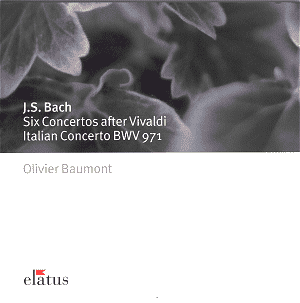When
Bach was in Weimar, he transcribed more than twenty concertos
for harpsichord or organ. More than just an activity which helped
him better know and learn from Italian composers - for most of
these transcriptions are from originals by Italians - Bach took
these works and created unique, original pieces for solo harpsichord.
Naturally, it is impossible to play on the harpsichord what a
string ensemble performs, and Bach made these works sound idiomatic
on the harpsichord, with the exception of the many full chords
they contain.
The
first movement of the F major concerto on this disc is a fine
example of how Bach transposed Vivaldi's unique melodies for the
harpsichord. The solo/tutti feeling of the string orchestra comes
through clearly as the right-hand part plays against silence or
very limited accompaniment at times, and at others sings out over
rich, full chords.
In
the slow, middle movement of this same concerto, Bach turns the
music into an improvisational-sounding passage with great beauty,
with wide arpeggios filling out the background to the "solo" melody
played with the right hand.
These
concerto are full of delightful surprises, and the opening allegro
of the D major concerto bubbles over with all the energy of Vivaldi's
music, yet is tamed with the restraint of the German music of
the times. The larghetto of this concerto - one of Vivaldi's most
memorable melodies - is magnificently balanced between the delicate
treble melody and the flowing arpeggios in the lower register.
Far
from being "mere" transcriptions, these concertos show that Bach
was both proud of his influences and open to learning from the
masters of his time. For, following these five concertos after
Vivaldi, Olivier Baumont plays Bach's own Italian Concerto, which,
in this context, takes on a new light. No longer is this seen
as an isolated keyboard work, containing brilliant virtuoso passages,
but as the natural successor to the many concertos that Bach transcribed.
Listening
to Bach's own "Italian" work after hearing these five concertos
helps put the Italian Concerto in better perspective. Baumont's
admirable performance shows how much Bach was influenced by the
Italian composers, but also how Bach took the style and went beyond
it. The three movements of his concerto are longer than most of
Vivaldi's, and Bach explores much more complex melodic material.
It's a shame that Bach only wrote one Italian concerto.
Baumont
plays this music admirably on a beautifully rich sounding harpsichord
by Anthony Sidey and Frederic Bal, which is a copy of a Silbermann
instrument from around 1735; certainly this instrument is similar
to what Bach himself may have played this music on.
This
very attractive recording is an excellent way to better appreciate
Bach's own influences, and discover the relationship between Italian
music and Bach's keyboard works. All Bach lovers should be familiar
with this music.
Kirk
McElhearn
